Mar 7, 2022 | coins, education, Red Book
 One of the more difficult things to explain to a new collector is how much a coin is worth. A common misconception is that an older coin is worth more than one struck later. Although I wrote two blog posts about coin pricing (links to Part I and Part II), the next question is, ”How much is my coin worth?”
One of the more difficult things to explain to a new collector is how much a coin is worth. A common misconception is that an older coin is worth more than one struck later. Although I wrote two blog posts about coin pricing (links to Part I and Part II), the next question is, ”How much is my coin worth?”
Collectors will turn to price guides to understand how much the coin is worth. Two popular price guides are the Guidebook to United States Coins (the Red Book) and the Coin Dealer’s Newsletter (the Greysheet). The Red Book is a book and requires the collector to purchase one. But for under $20, collectors can have the complete price guide of all United States Coins in their hands.
The Red Book does not have the most up-to-date coin values as a physical publication. But it gives the collector an idea of the value of their coins and is an excellent general reference.
Until recently, the Greysheet offered collectors their retail price guide to anyone visiting their website. While the website’s interface was more artistic than usable, the information was available to collectors.
Last week, Greysheet CEO John Feigenbaum sent an email to subscribers of their mailing list that announced the end of the free access to the retail price guide.
To access the retail price guide, collectors will have to create an account on their site to access up to 10 prices per month. After making 10 free queries, users will have to subscribe to their service for $7.99 per month, a price Feigenbaum says is “about the same as a Starbucks Frappucino — and a lot less calories.“ I prefer a tall three-shot latte that costs less and has fewer calories.
The fallacy of Feigenbaum’s argument is that they collect and publish the data regardless of the way they grant access. What has changed is that the cost of printing has risen. Instead of raising the prices for the printed version of the Greysheet and sister publications for the old dealers that are past their prime, the company passes the costs to collectors.
The Greysheet is a private company and can do what they want. As a collector who does not benefit from paying a monthly subscription to access retail price guides, it is time to add other online coin guide pricing tools. There are alternatives for the average collector. For example, NGC and PCGS publish price guides for coins in their holders. Find these price guides at:
When the need is for general online coin guidance, here are two good resources:
Even if the Red Book is not immediately accurate, it should be part of your library. As an essential reference, there is no comparable book.
Thank you to the Greysheet for providing the service in the past. But as it is time for you to move on, it is time for the ordinary collector to find other resources.
Aug 10, 2018 | books, Red Book
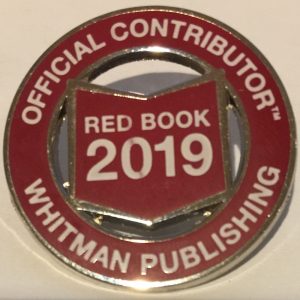 Although the 72nd edition of A Guide Book of United States Coins has been out since April, it seems like Whitman is doing a bit of behind the scenes reorganizing for the future. With Ken Bresett taking on the title of Editor Emeritus and Jeff Garrett taking over as Senior Editor, they seem to be a bit behind in some minor, but for some of us, important recognition. 😉 I finally received an Official Contributor’s pin for being a contributor to the Red Book.
Although the 72nd edition of A Guide Book of United States Coins has been out since April, it seems like Whitman is doing a bit of behind the scenes reorganizing for the future. With Ken Bresett taking on the title of Editor Emeritus and Jeff Garrett taking over as Senior Editor, they seem to be a bit behind in some minor, but for some of us, important recognition. 😉 I finally received an Official Contributor’s pin for being a contributor to the Red Book.
First, this is my public THANK YOU to Whitman for the pin and allowing me to participate!
As I did with last year’s edition, I participated in updating modern coin prices. Modern coins are those classified as being struck after 1964 when silver was removed from most U.S. coins. These are the coins that some dealers do not show a lot of love for because they are not perceived as worth the effort to sell. Although some of that has changed since the State Quarters were first introduced in 1999, the hobby should show more respect to these coins especially since we are 54 years into the modern era.
Although many feel that the Red Book’s pricing is obsolete when it comes out, it is still a good guide to understanding the foundation of pricing even if there is are market fluctuations. Thus, it would not hurt to get these prices closer to being correct, especially for new collectors. After all, this is a “guide,” not a price list.
This past year was a little different. Aside from not giving us a lot of time to enter prices (more on that later), my new business venture allows me to see the market from a dealer’s perspective. Even though I deal in general collectables and not just coins, I can now view the market from both sides of the counter.
Because of time constraints, I concentrated more on proofs and special issues than the business strike versions.
One of the reasons why the period for submitting our prices was delayed was that when Jeff Garrett took over as Senior Editor, a source said that he wanted to change a few things about how this was done. No details were provided.
I am speculating that the delay in sending out the contributor pins, which also comes with a copy of the Red Book and a Mega Red, is likely because Whitman is working diligently behind the scenes to make it easier for contributors to continue to help while giving Jeff and others a better platform for which to edit the prices.
Even though the Red Book is a good resource there are always ways to make it better. I am sure that Jeff will do a great job and hope that I can continue to contribute to the effort.
Mar 30, 2015 | Baltimore, BEP, books, coins, commemorative, Red Book, tokens, US Mint
 As it does three times per year, Whitman rolls into the Baltimore Convention Center for the Whitman Baltimore Expo. This time, rather than the showing being in Halls A and B it was held in E and F. The new location within the building was not as intuitive to find as walking to the end and Whitman did not do as good of a job as they could have in placing their signs. But for general access, which is was off of South Sharp Street, it provided a little better access than off of West Pratt Street, which is a main artery as it passes in front of the Inner Harbor.
As it does three times per year, Whitman rolls into the Baltimore Convention Center for the Whitman Baltimore Expo. This time, rather than the showing being in Halls A and B it was held in E and F. The new location within the building was not as intuitive to find as walking to the end and Whitman did not do as good of a job as they could have in placing their signs. But for general access, which is was off of South Sharp Street, it provided a little better access than off of West Pratt Street, which is a main artery as it passes in front of the Inner Harbor.
Although there were the same number of booths, the space felt smaller. Lights were brighter since these halls seem to have been converted to using LED lighting—the brighter space made the convention center seem less cavernous. Aisles were not as wide and some of the layout changed, but it seemed to have the same number of dealers. Some of the dealers who had larger spaces did downsize and the one vendor of supplies that is not Whitman did not set up at the show. It is not known if they decided not to attend or were not invited to attend. Since Whitman does not carry all books and supplies, it would be nice if they had another supplier.
On thing I have noticed is that since the death of numismatic book dealer John Burns in early 2014 there seems to be fewer numismatic book offerings at some of the east coast shows. Aside from missing his sharp wit, I was always able to find something a little off-beat or out of the ordinary amongst the books he had for sale. While there was a book dealer at this show, the items were more toward what I would consider ordinary. I hope someone steps in with some interesting items.
As I walked the floor and spoke to many of the dealers (late Friday afternoon), they all said that they were doing well. With the area still a bit chilly and no sports to take over the downtown Baltimore area (home opener for the Baltimore Orioles is on Friday, April 10), visitors to downtown Baltimore had plenty of time to visit. For those of us who like access to a major coin show, it is good to hear. If the dealers are doing well then they will keep coming back. If the dealers come back, the show goes on.
Both the U.S. Mint and Bureau of Engraving and Printing had booths at the show. While the U.S. Mint was showing current products, the Bureau of Engraving and Printing had some historical information. Although it is good to see the U.S. Mint at the show, it might be nice to see some historical artifacts. Since most of the U.S. Mint’s collection was given to the Smithsonian Institute, maybe they can be convinced to bring an exhibit to the show. Having the Smithsonian there would be very different than other shows since they have a different type of collection than the American Numismatic Association, for example.
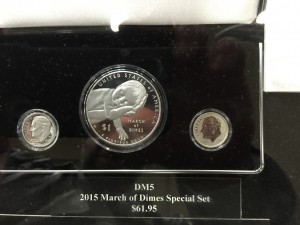
2015 March of Dimes Commemorative Proof set will cost $61.95 when released
Another interesting find was the First Edition of the Red Book Deluxe Edition. While flipping through it at the show, it looks like the Red Book on steroids. There is more information, more detail on pricing, and some other features. A first impression is that it extends the Red Book franchise a bit beyond what they called their Professional Edition. While there is a lot of information, my first impression is that I wish it was more of a cross between the Professional Edition and the Coin World Almanac. Both books have their places, but to combine the pricing and information that is updated yearly (the Coin World Almanac is updated every 10 years) would be a great resource. Hopefully, I will get my hands on one to review.
Finally, no show would be complete with out my one cool find. After walking the floor for a few hours I finally stat at the table of Cunningham Exonumia and had a nice chat with Paul Cunningham while searching for something New York. While I have not given up coins or Maryland Colonial Currency, I seem to be having more fun trying to find tokens and other exonumia from New York City and my hometown of Brooklyn. I have seen Paul at many other shows and have purchased from him. He always has a great selection. For me, I may have exhausted some of his inventory. This time, the pieces he was offering this weekend I already have in my collection.
But it did not stop me from looking. Tokens are very interesting. They are alternatives to money and are more tied to the culture of the community than money. For me, a New York Subway token not only represented a ride on the subway, but it also represents a different part of my life. It makes collecting very person. Although I have a collection of subway tokens I continue to look because you never know what you can find—especially an error.
What I found was a large token with an error. It was sold as the “Large Y” token where the “Y” was supposed to be cutout. Those tokens were used from 1970-1978 and two fare increases starting out at 30-cents in 1970, 35-cents in 1972, then 50-cents in 1975. But what I found is not that token. After examine the token carefully and some others I have, this is an error to the “Solid Brass NYC” Token. Introduced with the 60-cent fare in 1980, the “Y” was part of the raised design and not cutout. The clue as came when examine the obverse (the side that says “New York City Transit Authroity”). Between the “N” and the “C” is the tail of the “Y” but without its top. That tail would not have existed on the earlier tokens because they would have been cut out. Instead, the is a die issue where only the tail of the “Y” on one side was struck.
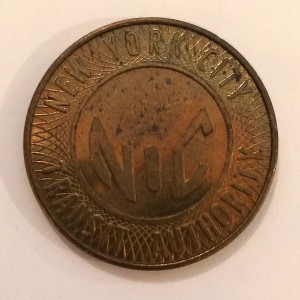
Large Brass “NYC Token” used from 1980-1985 with partial “Y” (obverse)
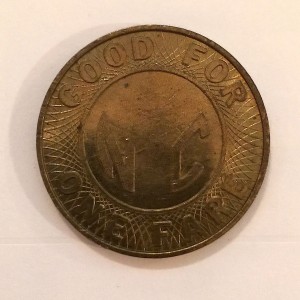
Large Brass “NYC Token” used from 1980-1985 with missing “Y” (reverse)
It might not be the error I expected, but it is an error nonetheless! It also does not make it any less fun or valuable because it will fit nicely in my collection.
If you were not able to make it Baltimore, here are some of the pictures I had taken at the show:
Mar 12, 2013 | books, coins, Red Book, review, values
Merriam-Webster’s online dictionary defines almanac as “a usually annual publication containing statistical, tabular, and general information.” Almanacs have been around for a while in various forms from the earliest times of writing to today. Early almanacs were simply calendars of coming events and records of past events. They included holidays, phases of the moon, and significant dates that related to the weather for the farming community.
Although there have been many almanacs that bridged into the modern era, none had been as famous as Poor Richard’s Almanack written by Benjamin Franklin writing under the pseudonym Richard Saunders. Franklin published Poor Richard’s Alamanck from 1733-1758. Amongst the surviving almanacs include The Old Farmer’s Almanac that has been published continuously since 1792, the Farmer’s Almanac that has been published continuously since 1818, and The World Almanac and Book of Facts published since 1868. These are the almanacs that all others are judged against.
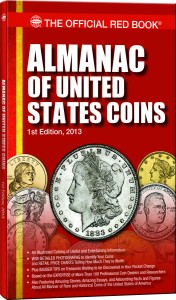 Having grown up with The World Almanac, reading the Central Intelligence Agency’s The World Fact Book, and being a begrudging fan of the Coin World Almanac, I was interested when Whitman Publishing sent out a notice that they just released the First Edition of the Almanac of United States Coins.
Having grown up with The World Almanac, reading the Central Intelligence Agency’s The World Fact Book, and being a begrudging fan of the Coin World Almanac, I was interested when Whitman Publishing sent out a notice that they just released the First Edition of the Almanac of United States Coins.
Although I read the description, I did not read it carefully because when I opened the package sent to me by Whitman, I found a skinny trade paperback-sized book. I reread the Whitman press release and it said the book was 192 pages. Initially, I felt disappointed in my hopes that there would be a competitor on the market to the Coin World Almanac since competition makes everyone better. So I can get over my initial reaction, I put the book down for a while to overcome my initial reaction to give the book a fair review.
After two weeks, I find I cannot hide my disappointment especially when I place the book next to the Coin World Almanac. Now in its eighth edition, the Coin World Almanac is 688 pages of numismatic reference that is a worthy comparison to any almanac in any industry. The problem with the Coin World Almanac is that it is updated every ten years. Having purchased the last two, the seventh edition seemed stale by 2004. I suspect the eighth edition will begin to feel stale by the end of this year if not by mid-2014. Maybe Coin World should consider shortening their update cycle.
Coin World does not have to worry about competition from Whitman. For as much as Whitman has invested in creating content across their “Official Red Book Series” from the many great authors, their Almanac of United States Coins is so lacking in content that it is many years away from being able to compete.
The only complement I can offer Whitman for this book is that many of the coin images are superb. I do like the images showing the relative grading of the individual series but wish it was expanded to include a few more grades. One example that would help collectors is that the difference between a VF-20 and MS-65 Walking Liberty half dollar is so vast, that having at least two intermediate grades (e.g., EF-40 and AU-50) would be helpful.
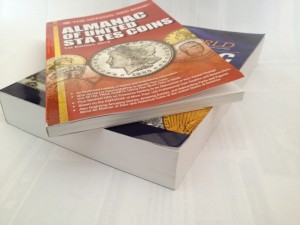
Whitman’s Almanac v. Coin World’s Almanac: In this case, size matters!
Whitman is going to have to learn that every numismatic reference book does not have to be a price guide. If they want to include type set-like guides, then do not make it look like a major component of the book. Otherwise, I would recommend people read A Guide Book of United States Type Coins instead. Thus the first improvement I would make is either eliminate the price guide information or find a way to minimize it as a central focus of each section. After all, an almanac is supposed to be about the content and the fact. Price guides are opinions that change with market forces that changes from the end of the editorial cycle until the book is published.
I know Whitman wants to sell books and has to find a way to make this book unique over their other offerings so they do not cannibalize sales, but they have to consider that they may never sell some of these books to certain people anyway. And if Whitman drops the pricing information, that still leaves their other books as an option for the reader. After all, Whitman can include a line at the end of each coin’s section that if they want in-depth information, the read can “consult” Whitman’s other book on the coin.
It is interesting how Whitman included a list of the authors for all of their books as credits but did not print the name of the editor of this book. However, Whitman’s press release named publisher Dennis Tucker as the editor.
Now that Whitman has disappointed me, they need to look at the content they have already invested in with their current books. They can start by taking whatever information is in the Red Book (A Guide Book of United States Coins), the Red Book Professional Edition, and the Blue Book (Handbook of United States Coins) and bring the content together to improve the current almanac. Just doing this would greatly improve this book. Then, it is a matter of an editor either convincing Whitman’s other authors to build on the chapters or distill the information in their other books to something suitable for an almanac.
I really wanted to like this book to the point that I put it aside in order to see if I could get over my first impression. Instead, I started to read another Whitman book that deserves the good review I will write in the near future. But I could not get over the disappointment. The text has no depth, facts that should be in an almanac are missing, and it seems like a glorified coin type price guide. Maybe they should market this as something for the very beginner, even for someone under the age of 12. Therefore I give this book a grade of F-12. The only factor that prevents this book from grading lower are the images. It is not a book I can recommend.
DISCLOSURE: Whitman Publishing provided the copy of the book I reviewed. I will not add this book to the library. It will be donated to my coin club’s annual charity auction in December with the proceeds going to the local Boys and Girls Club.
Cover image courtesy of Whitman Publishing.
Oct 3, 2011 | advice, apps, coins, education, Red Book, values
One of the most common questions I receive is “what is my coin worth?” Which is then followed by, “why is this coin not worth more?” Both are good questions that cannot be answered in a quick email since price is determined on market value which is heavily influenced by the coin’s condition. Let me explain…
First misconception is that the older the coin, the more it is worth. While some of this is true, there are exception. Copper coin enthusiasts will tell you that the 1910’s Lincoln Cents are worth more on avert than the 1900’s Indian Head Cents, rarities not withstanding. But those rarities are represented of one of the significant drivers in the cost of a coin: supply and demand. Simply, if there is a lower supply for the coin and a high demand, then the prices will be higher. For example, there were only 484,000 1909-S VDB Lincoln Cents struck before the U.S. Mint stopped production of the coins to remove the “V.D.B” initials on the reverse. Although nobody is certain how many have survived, it is difficult to find a collector who does not want one in their collection. Low supply, high demand means high price.
Many of what collectors call “key date” coins are those that are in low supply. But not all of those coins have the same demand. One example is the 1909-S Indian Head Cent with a mintage of 309,000. Even though the supply is lower than the 1909-S VDB Lincoln Cent, its demand is not as high. With the lower demand, the average price of the 1909-S Indian Head Cent is lower than the 1909-S VDB. But if you looked at the price of the 1909-S Indian Head Cent at higher grades, the Indian Head Cent is more expensive. This is because the first year Lincoln Cent was save in greater numbers and there are a few more higher grade examples available. Fewer of the 1909-S Indian Head Cents were saved leaving a lower supply making the coin more expensive for those demanding a higher grade coin.
That brings up the second factor of price: the condition of the coin. The better the condition the more expensive the coin. Using the 1909-S VDB Lincoln Cent for an example, the “book price” of a brown cent (BN) in the average grade of Extra Fine (XF-40) is $1,300. If it was at the low end of being Uncirculated (MS-60), the coin is worth $1,680. A coin that has some mint red luster that can be classified as red-brown (RB) makes the coin worth $1,720. In higher grades, such as MS-65, the difference between having a 1909-S VDB in BN ($3,060) differs significantly from a RB cent ($4,230) which is less than if it was a full blazing red cent ($6,440).
Condition is a key factor. Even if you were to look up the price of a coin in almost any reference, you will find that the price is different for each grade. It is important that you know the grade of the coin. For U.S. coins, one of the best online resources for helping grade coins is PCGS Photograde Online. PCGS Photograde Online contains high quality images of pre-1964 coins in all grades so that you can compare your coin with the online images. If you have an Apple iPhone or iPad, you can download the app from the iTunes App Store (Photograde app was previously reviewed here).
Even with knowing the condition and rarity of the coin, pricing is more of an art than a science. Publishers of price guides look at market condition, reports of how coins are selling, auctions, and other factors to determine what they think a coin should be worth. Just remember, these guides are just guidelines. They are not definitive prices. Individual dealers set their prices based on how much they purchased the coin for, consignment agreements, what the price guides suggest, along with extra to make a profit. Depending on the dealer, coin, and circumstances, these prices are not firm and can be negotiated. However, if you are negotiating for a coin, you should know what the fair market value is of the coin. Otherwise, you will make the dealer upset and might not sell you the coin regardless of the price.
Negotiating tips will be the topic of another post in the near future.
A good place that I have found to determine what the fair market value is the NumisMedia Fair Market Value Price Guide. NumisMedia allows all web visitors to view the fair market values of the coins in all grades. For those at shows or visiting a coin shop doing quick research on their smartphone, NumisMedia offers a mobile version of their fair market value website at m.numismedia.com.
If you collect foreign coins, there are few, if any, online resources. Since I have an interest in Canadian coins, the best single reference is the Charlton Standard Catalogue, Canadian Coins. Now in its 66th edition, it is the definitive reference on everything minted by the Royal Canadian Mint and those issued by the provinces before the union. One minor drawback is that the images are in black and white. Also, the book is not available as an e-book, which would benefit mobile users.
The ultimate reference guide for world coins is the Standard Catalog of World Coins from Krause Publications. Not only are there volumes for the 18th, 19th, 20th, and 21st century, but all four volumes are available as PDF files on DVDs. Once the files are copied to your system, they can be downloaded to your e-reader or mobile device for taking on the road. The files are searchable and can help price your world coins. If you do not want the full catalog but want a few countries or regions of interest, Krause offers their “Coins of the World” for downloading. This will allow you to download on the section of the Standard Catalog that you are interested in.
Krause also offers sections of their U.S. Coin Digest for each coin type for download. This is a good service for those interested in just one type. For obsolete bank note collectors, Krause also offers sections of the multi-volume Standard Catalog of United States Obsolete Bank Notes by James A. Haxby as a per state download.
Other references you might consider are Whitman’s A Guide Book of United States Coins, also known as the “Red Book,” and Krause’s U.S. Coin Digest. Both traditional references are available for your favorite e-reader making them easily searchable and portable.
Using these references should help you understand what your coin is worth and why. Now go forth and build your collection!
Apr 27, 2007 | ANA, coins, Red Book, shows
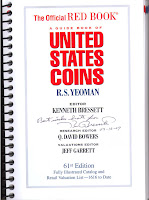 After the ANA National Money Show in Charlotte I wrote about meeting Ken Bressett, the editor of the Red Book. Bressett was at the Whitman Publishing booth autographing copies of the newly released 2008 Red Book. Rather than purchase my copy from a dealer, I could not pass up the opportunity to have one autographed by Ken Bressett.
After the ANA National Money Show in Charlotte I wrote about meeting Ken Bressett, the editor of the Red Book. Bressett was at the Whitman Publishing booth autographing copies of the newly released 2008 Red Book. Rather than purchase my copy from a dealer, I could not pass up the opportunity to have one autographed by Ken Bressett.
Bressett is a small, slight gentleman who is very gracious and pleasant. When I arrived at the table where Bressett was having a conversation with what seemed like an acquaintance, Bressett excused himself to speak with me. Unfortunately, I stammered like a star-struck teenager not knowing what to say to this icon of the industry. While being at a loss for words is not a usual occurrence, Bressett eased into small talk about the show.
For many years, the Red Book was the price guide for collectors. It was the first numismatic book I owned in the early 1970s. While that book is no longer part of my collection after being lost in one of my many moves, this autographed copy of the Red Book is now on my desk and will remain one of my treasured possessions.
 One of the more difficult things to explain to a new collector is how much a coin is worth. A common misconception is that an older coin is worth more than one struck later. Although I wrote two blog posts about coin pricing (links to Part I and Part II), the next question is, ”How much is my coin worth?”
One of the more difficult things to explain to a new collector is how much a coin is worth. A common misconception is that an older coin is worth more than one struck later. Although I wrote two blog posts about coin pricing (links to Part I and Part II), the next question is, ”How much is my coin worth?”




 Having grown up with
Having grown up with 

